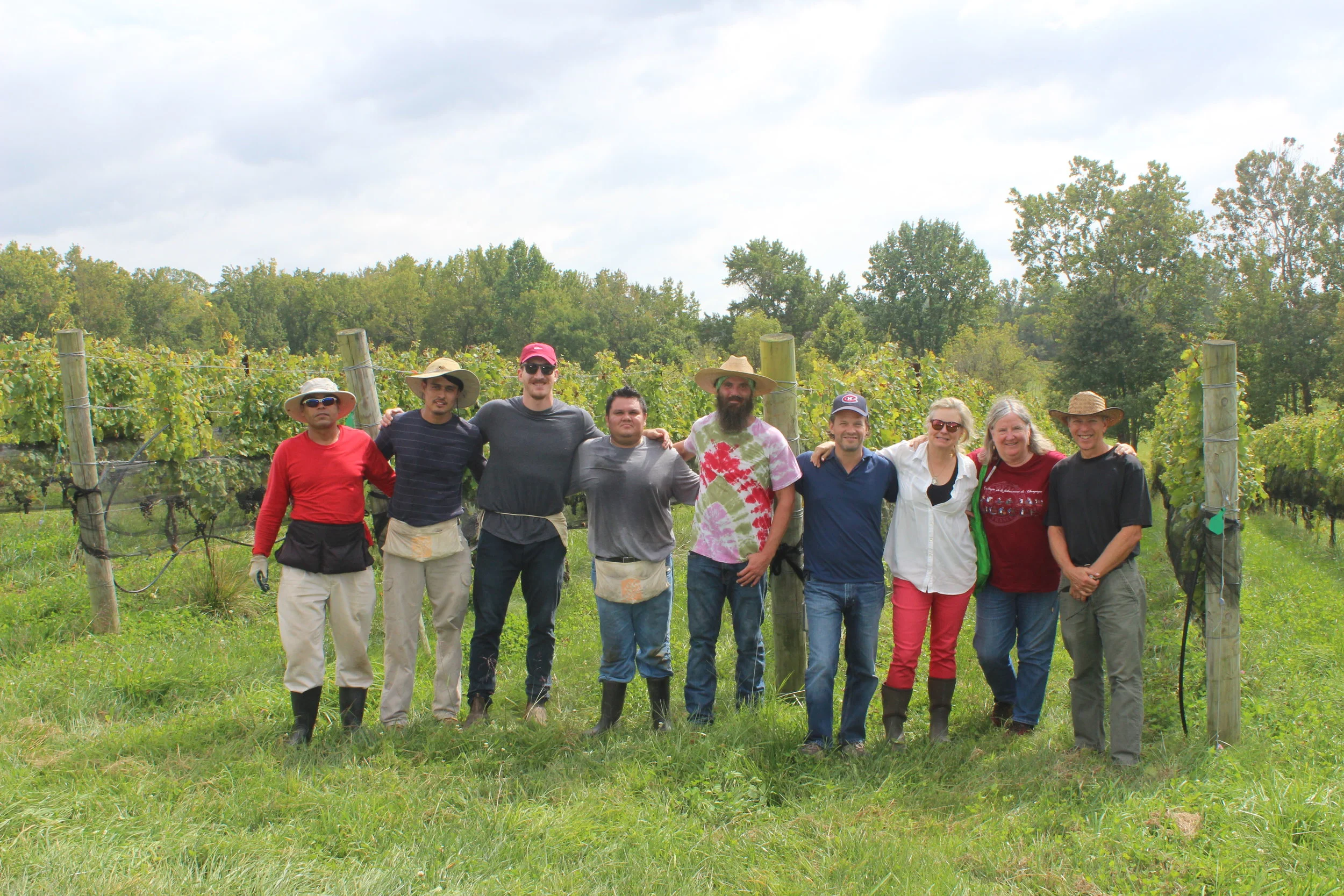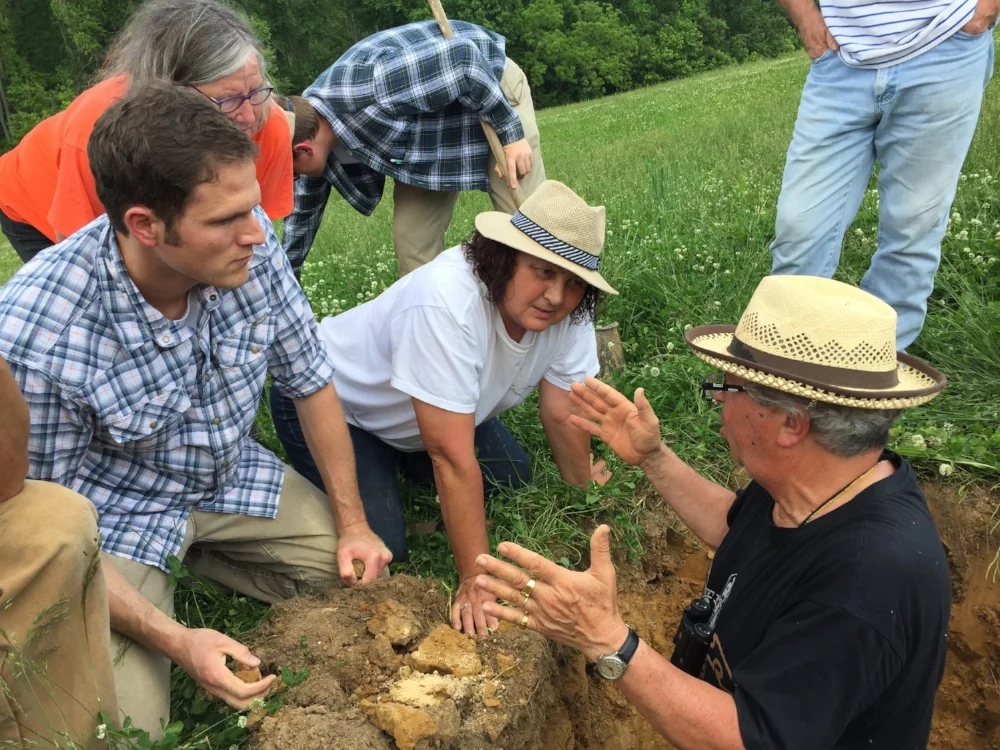In my last post on organic agriculture, I discussed the importance of balance in the vineyard, especially in the soil where microbes play a critical role in creating a healthy environment for plant growth. This notion of ecological balance is central to a form of organic agriculture known as biodynamics.
2017 Vintage Summary: A Year of Providence
In what has become a metaphor for the 2017 vintage, a black widow found her way onto the sorting table in the last hours of harvest. We’ve always known that there are lots of black widows in the vineyard, but mostly they keep to themselves, quietly helping rid the vines of unwanted insects. How she got to the table is anyone’s guess. It seems unlikely that she was on a cluster when it was snipped into an unsuspecting hand, so perhaps she crawled into a picking basket that inadvertently landed on her web. In either case, we popped both the spider and her grape into the sorting bin, and off she went to the compost pile. No harm done to either party.
Thoughts from the Barrel Room
With the red harvest complete, and extended macerations underway, I’m starting to think more concretely about how barrel aging will affect the wine and how we can use this understanding to enhance quality. It goes without saying that barrels are not neutral vessels. Aromatic substances in oak quickly diffuse into wine, and some of these combine with or react with substances in the wine to create new flavors. It’s a bit like using spices while cooking. A little bit can enhance the natural flavor of the ingredients, adding complexity and depth. Too much can hide great ingredients, and faulty ones. Oak also contains tannins that have both beneficial and detrimental effects on wine.
August Updates
The bird nets are all up, so our attention is quickly turning to preparing to bottle 800 cases of wine this Friday, August 18. I’m excited about all the wines, especially the 2015 Oronoco and Dungannon. We’re also getting ready for the harvest. The season has been shaping up nicely. Veraison came early, July 20 in Block 40 (Merlot), and went quickly, with superb uniformity across all the blocks. This means that the fruit will ripen evenly and allow us to fully extract all the flavors, always an exciting prospect for a winemaker. The modest rains have kept the wines in peak condition, allowing photosynthesis to work its magic, as have the cooler temperatures with lots of clear sunshine.
What are Dodon Soils?
Dodon’s soils substantially differ from those in other wine growing regions. Termed Marr-Dodon complex soils, they are described as fine-loamy (meaning smallish particle size), siliceous (having high levels of silica that warms the soil), semiactive (modest cation exchange associated with low fertility), mesic (medium temperature), aquic (Dodon series) or typic (Marr series) (aquic soils retain more water than typic) hapludults (derived from sandstone).
The Story of Drum Point
Those who have visited know that Dodon has a rich and varied history. To celebrate this heritage, we’ve chosen historical themes when naming Dungannon, Oronoco, and Drum Point, Dodon’s Collectors wines. In this article, we share the story of the Drum Point Railroad.
Occasional Notes
Winter 2017 Update
Winter is pruning time, and no matter how long we think it will last when viewed from November, the season always passes too quickly. There are lots of competing demands, and sometimes, like this year, it is cut short by warm weather. But like all cultural practices in the vineyard, we don’t cut corners.
Why do we care so much about Dodon soils?
Grapevines grow just fine in water supplemented with a few nutrients, a method known as hydroponics. Growing hydroponically has lots of advantages. Because it can be done indoors, hydroponics allows perfect temperature control, and it avoids disease pressure often associated with rain, humidity, and insects. Vegetative growth can easily be regulated by adjusting the amount of carbon dioxide in the atmosphere and the amount of nitrogen in the aqueous solution. It’s little wonder that tomatoes, lettuce and other vegetables, and most commercial marijuana are grown hydroponically.
Looking Beyond Organic Certification: Part I
I’m often asked when leading guests on a tour in the vineyard whether Dodon is “organic,” or at least aspires to be certified as an organic vineyard. It’s a fair question. In many ways, we fit the common image of organic farmers. On a summer visit, you will find our vineyard team out with hoes, clippers, and other hand tools, carefully cultivating the soil and tending the vines. Regulations governing organic certification require practices that are standard operating procedures at Dodon, such as use of organic composts, mechanical weeding, and use of biological controls for insect pests. These methods are labor intensive and expensive, and they illustrate our commitment to sustainability, ecologically-friendly practices, and a balanced ecosystem.
Happy New Year
Happy New Year! We just left the cellar, sniffing, tasting, listening, and stirring one last time in 2016. The ‘16 vintage is coming around nicely. The Sauvignon Blanc and Rosé are developing the flavors and weight that characterize the Dodon site. They’ll be ready for bottling March. The Chardonnay has finished themalolactic fermentation and is settling in for its year-long elévage. The primary fermentations (the conversion of sugar to alcohol) are yet to finish in the reds, but the familiar snap, crackle, pop from the bung hole prove the yeast are still working.
2016 Vintage Summary
The red wines are now in tank, primary fermentations nearly complete, extended macerations underway, and the conversion from malic acid to lactic acid getting starting. While the next movement of the vintage is still being written, the personality of the growing season is now clear. Starting, as spring always does, with anticipation and hope, the rhythm quickly began alternating between moments of dramatic threat and pastoral idyll. Like Sibelius’ second symphony, the sense was that of an ongoing conversation between death and salvation, personified by increasing tension, fatigue, and anxiety before ending in a final heroic conclusion.
One Winegrower's Take on GMOs
Support for genetically modified organisms or GMOs got quite a boost this summer when the National Academy of Sciences released their most recent report on GMOs, concluding that, compared to “conventionally” farmed crops, GMOs have had generally, but not uniformly, positive effects on producer income and that they are safe to eat. To be sure, the NAS committee comprehensively reviewed the literature comparing GMOs with conventionally farmed crops, so from this perspective, it fulfilled its narrow statement of task. But many winegrowers will view the scope of the report as limited, comparing two largely technologically driven agricultural methods but leaving out more ecologically-based methods that rely on diversified ecosystems to improve quality and increase yields.
News from the Vineyard: A June Update
The Bordelais say that the quantity of the vintage is determined in June and its quality is determined in September. That’s not quite true, but now that we’ve finished bloom and the fruit has set, we have a good sense that that the 2016 vintage will be on the small side. It started with the early bud break at the end of a very warm March, followed by two hard freezes in early April, and then cool, wet weather through the rest of April and most of May. The necessary handwork in the vineyard was unpleasant, and managing the tractors was tricky and sometimes dangerous.
Are Time and Terroir an Illusion? Reflections on Mark Matthews’ new book, Terroir and Other Myths of Winegrowing.
Issac Newton described time in absolute terms that I find intuitive. It is the same everywhere, it has constant duration, and it flows continuously in the same direction. According to Craig Callender, Professor of Philosophy at University of California, San Diego, Newtonian time is a kind of master clock that carves our world into instants.
2015 in Review
It was a busy year around Dodon. In February, Matthieu Finot joined the team as consulting winemaker. Matthieu’s training in Burgundy and his 23 years in Virginia bring remarkable experience and a steady hand to the cellar team. In March, we were joined by vineyard consultant Lucie Morton and geologist Bubba Beasley to map the vineyards using electromagnetic induction. Our immediate motivation was to find those areas most appropriate for each varietal for our April planting of eight acres and 16,000 vines.
The Dungannon Legend
As those of you who have toured the vineyard with me know, we’ve spent a great deal of time trying to understand Dodon’s ancient soils and the agriculture that has influenced their current expression. One dominant theme is tobacco, which stripped much of the land of organic matter, nutrients, and microbial activity, making this a terrific site for wine growing. We often comment that we can taste these old tobacco plantings in our Cabernet Sauvignon, enough so that we decided to call our Cabernet-based blend “Oronoco” after the variety of tobacco grown here.
Dancing with Nature
We are often asked in the depth of winter about the effect of cold temperatures on the vines. Usually, the answer is that cold weather during winter dormancy is good for them. Chardonnay and Merlot are the least cold hearty varieties at Dodon, and even these tolerate temperatures as low as -3 degrees F before there is any bud loss.
2013 Harvest Review
2013 Harvest Update
Harvest is what we work for. And now it’s in full swing. The Sauvignon Blanc and Chardonnay are in the cellar, settled, and the fermentations started. We started slow, a good warm up for the new cellar, with just 750 pounds from the third leaf SB in block 12. The fruit was very ripe, brix 23.8 for those who care about sugar levels, and very clean. Young vines always yield less fruit, but even we were surprised a few days later when the fourth leaf SB in block 11 produced 3000 pounds from less than a half acre. We’re fermenting those two lots separately, very slowly, but we’ll eventually bring them together to produce a delightful wine, with Block 11′s slightly less ripe fruit bringing SB’s characteristic aromatics to merge with fullness on the mid-palate contributed by Block 12. In the cellar, it’s remarkable to taste the emerging wine each day, spritzy and sweet, and complex with yeast as the fermentations get rolling.













